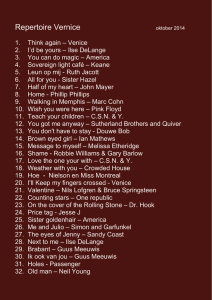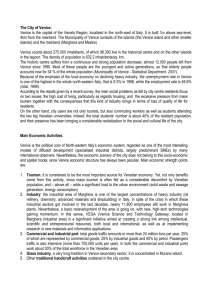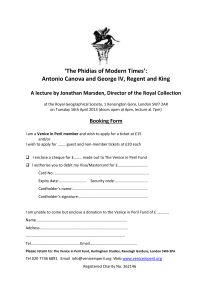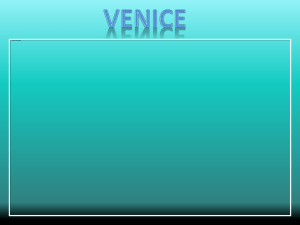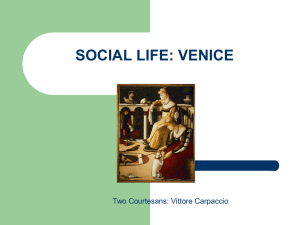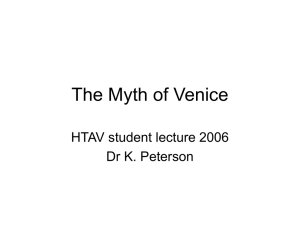PI_4_Architecture_in_Venice
advertisement
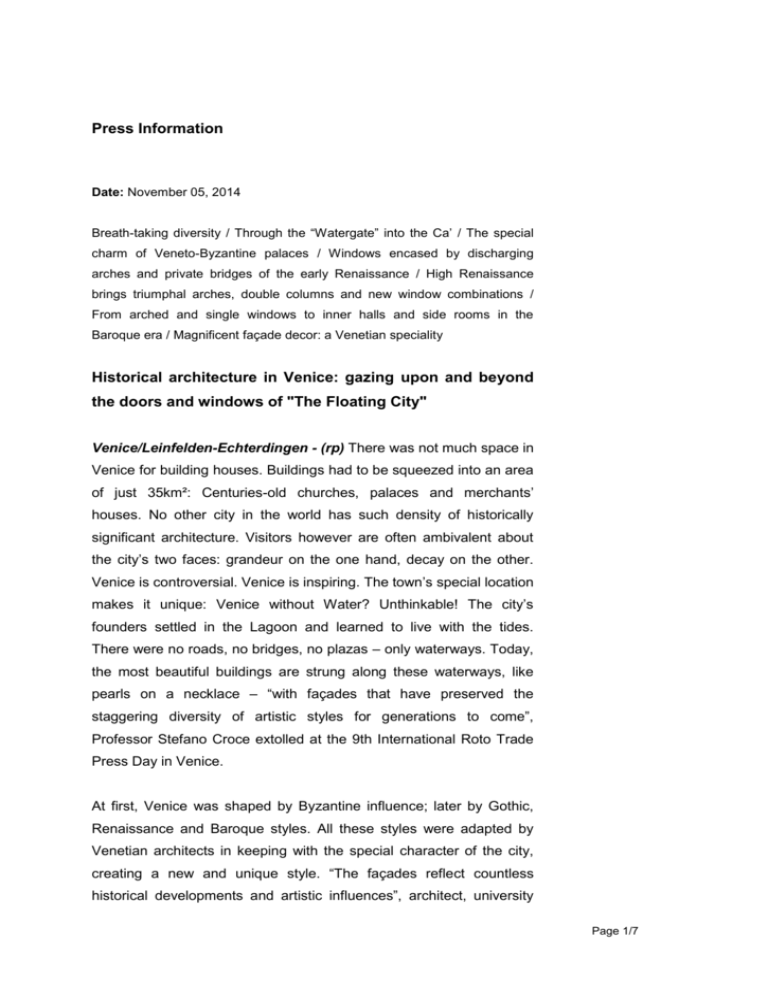
Press Information Date: November 05, 2014 Breath-taking diversity / Through the “Watergate” into the Ca’ / The special charm of Veneto-Byzantine palaces / Windows encased by discharging arches and private bridges of the early Renaissance / High Renaissance brings triumphal arches, double columns and new window combinations / From arched and single windows to inner halls and side rooms in the Baroque era / Magnificent façade decor: a Venetian speciality Historical architecture in Venice: gazing upon and beyond the doors and windows of "The Floating City" Venice/Leinfelden-Echterdingen - (rp) There was not much space in Venice for building houses. Buildings had to be squeezed into an area of just 35km²: Centuries-old churches, palaces and merchants’ houses. No other city in the world has such density of historically significant architecture. Visitors however are often ambivalent about the city’s two faces: grandeur on the one hand, decay on the other. Venice is controversial. Venice is inspiring. The town’s special location makes it unique: Venice without Water? Unthinkable! The city’s founders settled in the Lagoon and learned to live with the tides. There were no roads, no bridges, no plazas – only waterways. Today, the most beautiful buildings are strung along these waterways, like pearls on a necklace – “with façades that have preserved the staggering diversity of artistic styles for generations to come”, Professor Stefano Croce extolled at the 9th International Roto Trade Press Day in Venice. At first, Venice was shaped by Byzantine influence; later by Gothic, Renaissance and Baroque styles. All these styles were adapted by Venetian architects in keeping with the special character of the city, creating a new and unique style. “The façades reflect countless historical developments and artistic influences”, architect, university Page 1/7 lecturer and author Professor Croce explained in his presentation “Historical architecture in Venice – gazing upon and beyond the doors and windows of the city”. The composition principle of Venetian palaces – that is, the placement of doors and windows – has remained the same over the centuries, as has the basic layout of the buildings: The first floor had a store-room and a watergate leading to the canals. The second floor was the so called “piano nobile” ("noble floor”) with reception halls and arcades leading to the loggia. Typically, the palazzo’s roof was adorned with a parapet topped with crenellations. In later times, additional floors were added. Through the “Watergate” to the Ca’ Flourishing sea trade made Venetian merchants immensely rich. As their trading activities took these merchants to the Orient, they became fascinated by Byzantine architecture. The façades of their palazzos had countless windows and balconies, representing the owners’ pride in their own achievements. According to Professor Croce, entrances were built for different purposes, some of them enabling boats to unload their merchandise. Over time, these watergates or galleries, sometimes referred to as “water portals”, evolved into prestigious entrances and luxurious reception halls. Venetians did not refer to their palaces as “palazzos”, but called them “ca” – short for “casa” (house). This understatement was meant to emphasise the equality of all noble families. Only the most prominent buildings – such as the Doge’s Palace or the Bishop’s Palace – were called palazzo. The special charm of Veneto-Byzantine Palaces One of the best-preserved examples of the Veneto-Byzantine style of the 13th century is Ca’ Corner (often referred to as Palazzo LoredanCorner). Although it later underwent substantial expansion and remodelling, it has retained its special Byzantine charm: a great variety of arches atop marble columns with Byzantine capitals and Page 2/7 imposts, engraved with floral ornaments and animals and above the arches, circular reliefs of mythical creatures. Venice reached its zenith of wealth and power during the 13th to 15th centuries, the era of Gothic Art. This style left the most profound mark on Venetian architecture. Its emphasis on lightness and grace in structure proved perfect for building on unstable, marshy soil. The palaces in Venice blended Gothic and Byzantine elements: The Gothic lancet arch dominated loggias, adorned with tracery and flanked on either or both sides by a narrow façade with windows on it. Over the years, arches of different shapes and styles became increasingly fashionable: from cusped arches with a Moorish touch to ogee and trefoil arches crowned with finials, as well as the specific local version of the late Gothic era’s Flamboyant Style. Windows encased by discharging arches and private bridges of the Renaissance Venetians were traditionalists; therefore it was hard for Renaissance architecture to become accepted in the city of lagoons. It took until the mid-15th century for this new modern style – already well-established at that time in central Italy – to emerge in Venice. When it finally began to spread, Renaissance architecture reached new artistic heights in Venice. An outstanding example is Ca’ Vendramin Calergi, built in the years 1481 to 1509. This elegant building, which is currently home to the Casino Municipale di Venezia, still displays the hallmarks of Renaissance palaces on its façade: columns, prominent string courses and discharging arches, each encasing a small circular and a two-light window. Ca’ Vendramin Calergi has landward access. As Prof. Croce explained, by the mid-15th century Venetians begun to build large landward entrances. What is more: “Private bridges also proved a practical solution.” Even if some of them did not provide direct access to the entrance door, they were part of the private access ways, which could be locked by the house owner. As the city’s Page 3/7 population grew and demand for public infrastructure was increasing, these hitherto private bridges were nationalised. The second phase of Venetian Renaissance, the classical period, begun in the 16th century. At its peak, palaces were adorned with large arcades and columns in colossal order. Façades became heavier, lines graver. The airiness was lost. Mascaron ornaments on round arches, high rectangular windows with segmented pediments as hood moulding, fluted or double pilasters and heavily protruding balconies characterised the façades of Venetian palaces. Instead of building only one imposing façade facing the waterway, now both fronts of the building were ornamented. While houses had previously been built to the same height, the new buildings were made of massive stone blocks and towered over the older ones. Being heavier, they required more robust foundations. High Renaissance brings triumphal arches, double columns and new window combinations An outstanding example of this development is Palazzo Grimani. Construction started in 1556, resulting in a building that seemed to crush all adjacent houses. The ground floor is dominated by a façade element which is inspired by a triumphal arch. It marks a trend, which according to Prof. Croce was characteristic for public palaces. The central arch takes up the entire height of the ground floor, while the arches on the left and right side are much lower. Overlapping windows indicate a mezzanine floor. The triumphal arch motive is repeated on the first floor at the center in slightly altered form: as a floor-to-ceiling Palladian window. Low, rectangular windows on the side are augmented by fanlights. The ground floor façade is vertically structured by pilasters, on the upper floor columns are used for the same purpose. For the first time, a Venetian palace boasted what appeared to be an end-to-end balcony. On the inside, Palazzo Grimani has a three-part structure, which is apparent from the double columns on the façade. A large round arch at the palace entrance Page 4/7 opens onto the courtyard in the back, which can also be accessed through the landward entrance. From arched and single windows to inner halls and side rooms in the Baroque era “Many palaces and public buildings of the Renaissance era had prestigious landward entrances,” Prof. Croce explained. Many of these entrances were built in a monumental style, such as that of a triumphal arch. Large inner portals were also built for reasons of prestige, while having no practical use whatsoever. With the classical Renaissance style and emerging Baroque architecture, the principle of repetition on façades became obsolete. Now there was a clear differentiation between arched and single windows. Their position and design shed light on the rooms in the building: Central openings typically led to inner halls and single windows to side rooms. This principle is clearly visible in the construction of the Ca‘ Rezzonico, one of the most magnificent museums in Venice. Built at the end of the 16th century in Venetian Baroque style, on the ground floor there is an entrance hall with two windows on each side. Each of the seven equal windows of the second and third floor have a balcony in front. The fourth floor has no oval windows. The rectangular palazzo houses an inner courtyard decorated with a fountain and there is a magnificent double-height ballroom at the rear of the building. Sadly, neither the architect, nor the owner lived to see the palace completed. After numerous modifications, the building was finally finished at the end of 1756, by a new architect and a new owner. Magnificent façade ornaments: a Venetian speciality Typically a palace’s façade used to be plain and cool: string courses were used to structurally separate floors, pilasters were built to add vertical emphasis. Not so the façades in Venice: “Many additional ornaments were added as eye-catchers, later becoming characteristic Page 5/7 features of this style”, Prof. Croce concluded. Ca’ Vendramin Calergi is a good example: terrazo floors, sculptures, frescoes, cornices with or without figurines, wall niches, pediments, fluted and annulated columns characterise the centuries-old Venetian decorative traditions. So it is well worth taking a closer look at Venetian façades with their splendid windows and doors and a tour through the idyllic canals is the perfect way to do so: Venice is not just a city on the sea, but a unique outdoor museum. Captions One of the best-preserved examples of the Veneto-Byzantine style of the 13th century is Ca’ Corner (often referred to as Palazzo LoredanCorner). Although it later underwent substantial expansion and remodelling, it has retained its special Byzantine charm: A great variety of arches atop marble columns with Byzantine capitals and imposts, which are engraved with floral ornaments and animals. Above the arches circular reliefs of mythical creatures. Ca’_Corner.jpg Photo: Roto / Croce Ca’ Vendramin Calergi was built in the years 1481 to 1509. Currently it is home to the Casino Municipale di Venezia. The elegant building still displays the hallmarks of Renaissance palaces on its façade: Columns, prominent string courses and discharging arches, each encasing a small circular and a two-light window. Photo: Roto / Croce Ca’_Vendramin_Calergi.jpg Palazzo Grimani was built at the height of the Renaissance period. A triumphal arch-like element in the center of the facade dominates the ground floor. The central arch takes up the entire height of the ground floor, while the arches on the left and right side are much lower. Page 6/7 Overlapping windows indicate a mezzanine floor. The triumphal arch motive is repeated on the first floor at the center in slightly altered form: as a floor-to-ceiling Palladian window. Low, rectangular windows on the side are augmented by fanlights. Photo: Roto / Croce Palazzo_Grimani.jpg Ca‘ Rezzonico is one of the most beautiful museums in Venice. Built at the end of the 16th century in Venetian Baroque style, on the ground floor there is an entrance hall with two windows on each side. Each of the seven equal windows of the second and third floor have a balcony in front. The fourth floor has no oval windows. Ca’_Rezzonico.jpg Photo: Roto / Croce Having graduated from Istituto Universitario di Architettura di Venezia in historical architecture, Prof. Stefano Croce is an expert on historical architecture in Venice. He has been in charge of numerous refurbishment projects in Italy and has been teaching at several renowned universities abroad. The author of numerous scientific papers on restoration gave a presentation on the occasion of the 9th International Roto Trade Press Day. Prof Croce spoke to internationalist journalists about Venetian palaces and the “breathtaking diversity of their façades - for eternity”. Photo: Roto / Croce Stefano_Croce.jpg Print free – copy requested Publisher: Roto Frank AG • Wilhelm-Frank-Platz 1 • 70771 Leinfelden-Echterdingen • Tel. +49 711 7598 0 • Fax +49 711 7598 253 • info@roto-frank.com Editor: Linnigpublic Agency for Public Relations GmbH; office Koblenz • Fritz-von-UnruhStraße 1 • 56077 Koblenz • Tel. +49 261 303839 0 • Fax +49 261 303839 1 • koblenz@linnigpublic.de; office Hamburg • Flottbeker Drift 4 • 22607 Hamburg • Tel. +49 40 82278216 • Fax +49 40 82278217 • hamburg@linnigpublic.de Page 7/7

